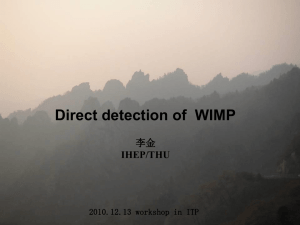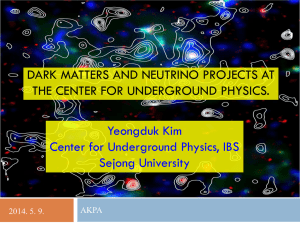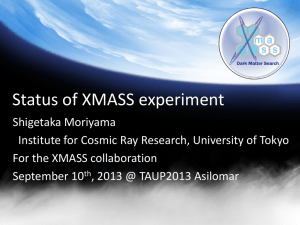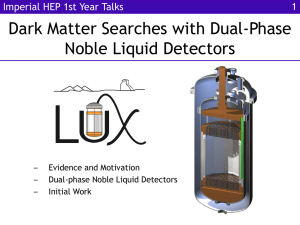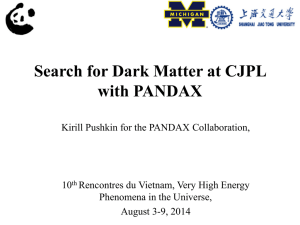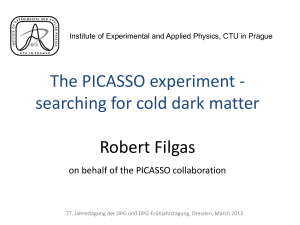LUX: A Liquid Xenon Dark Matter Detector
advertisement
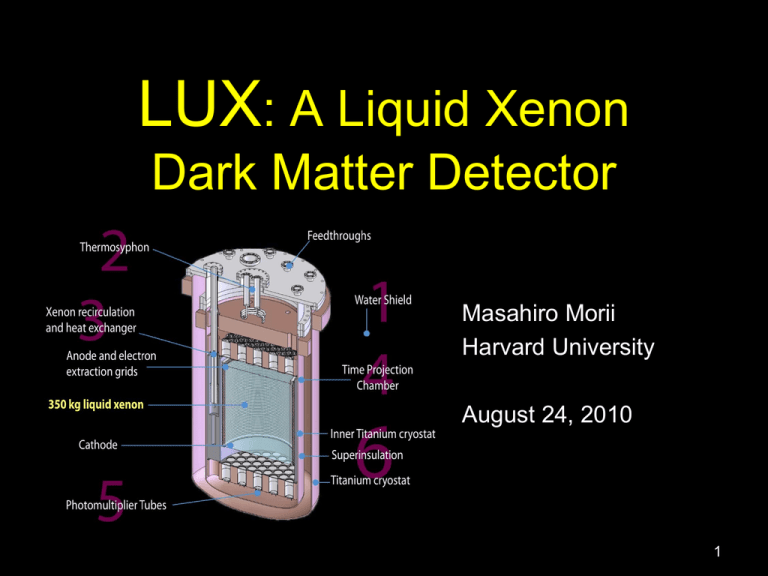
LUX: A Liquid Xenon Dark Matter Detector Masahiro Morii Harvard University August 24, 2010 1 New Physics — Where? From the labs — Unexplained experimental data Ex: nuclear decays violate energy conservation neutrinos Much of the 20th-century particle physics was driven by data Today: all HEP data are consistent with the Standard Model From imagination — Quest for consistency/symmetry/beauty Ex: equivalence principle general relativity Few of the many brilliant ideas succeed Today: too many ideas to fit on this slide From the sky Ex: matter-dominant universe CP violation Particle physics and astronomy must agree on the observable universe Today: Dark Matter and Dark Energy 2 Evidence for Dark Matter Overwhelming evidences for Dark Matter from astronomy Observed motions of stars and galaxies Rotational curves in galaxies Velocity dispersions in galaxy clusters Mass distribution measured with gravitational lensing Cluster mass-light ratios from strong lensing Cluster mass maps in clusters from weak lensing Smoking gun: Separation of visible and dark matters in colliding clusters Bullet cluster 3 Abell 520 “the train wreck” cluster 4 Lambda-CDM Universe Observation has improved dramatically in the last decade Cosmic Microwave Background anisotropy (WMAP) Accelerating expansion of the Universe (Type-1a SNe) Large-Scale Structure (2dFGRS, SDSS) Light-element abundances & Big-bang nucleosynthesis Data support a universe with a positive cosmological constant and Cold Dark Matter — CDM model What (we think) we know Wbaryon 0.0456 ± 0.0015 WCDM 0.228 ± 0.013 Cold Dark Matter WL 0.726 ± 0.015 Dark Energy Wtotal 1.005 ± 0.006 Flat Universe WMAP, Astrophys. J. Suppl. 180 (2009) 225-245 5 What We Know About DM Dark Matter must be there ~23% of the energy of the Universe Dark Matter is not part of the Standard Model Non-baryonic No electromagnetic interactions Stable Cold: non-relativistic in early Universe to create the LSS Near the Solar System Local density: ~0.3 GeV/cm3 Give or take a factor of 2 Velocity: assumed to be Maxwell-Boltzmann with v ~ 230 km/s Simplest model, but not necessarily true 6 What is DM Made Of? Neutrino SM neutrinos are too light Heavy sterile neutrino? WIMP ~100 GeV mass particles with Electroweak interactions Axion Cold even with small masses SuperWIMP Weaker-than-EW interactions Axino, gravitino, KK gravitons Many many others ... Roszkowski, hep-ph/0404052 7 WIMP Candidates Many theories beyond the SM predict new particles at O(100 GeV) A result of attempting to solve the hierarchy problem A conserved quantum number makes the WIMP stable Theory Symmetry WIMP Supersymmetry R parity Lightest Supersymmetric Particle Little Higgs T parity Lightest T-odd Particle Universal Extra Dimension KK parity Lightest Kaluza-Klein Particle This ensures that WIMPS are created/destroyed in pairs 0 f f c%1 Canonical example is(B, the neutralino % %,H %) W%0lightest ) (H Admixture of gauginos u d and higgsinos If they existed, how many WIMPs would be out there? 8 WIMP Relic Density WIMPs were in thermal equilibrium with Standard Model particles after inflation As the Universe cools, their density drops as Ê T ˆ˜ Á ˜˜ nc µ exp Á Á ˜ Á Ë m c ˜¯ freeze now This goes on until the WIMP annihilation rate becomes smaller than the expansion rate, i.e., GA = nc s Av <H Feng, arXiv:1003.0904 [astro-ph.CO] The WIMPs freeze out with the relic density Wc µ 1 s Av ª m c2 gc4 m = 100 GeV and g = gEW observed Dark Matter density Formula above depends on gravity (mPl) and Hubble constant (H0) — No relation to electroweak physics 9 WIMP Hunting Going beyond gravity, three ways to detect WIMPs WIMP pair production at hadron colliders f f Indirect detection of radiation from pair annihilation Direct detection of WIMP scattering off a nucleus 10 WIMP Hunting Hadron colliders produce WIMPs through decays of new particles e.g., gluino production followed by a long cascade ending in a neutralino Production rate depends on details of the particle spectrum If a WIMP is found, it’s hard to identify it with the cosmic Dark Matter Does it live cosmologically long? What is its coupling? Indirect searches rely on WIMP pair annihilation in the regions of high WIMP densities e.g., Galactic center, Solar core Annihilation rate depends on the local density profile Backgrounds are poorly understood Are there local sources of energetic radiations, e.g., pulsars? Direct searches depend on the local WIMP density velocity v 2 and = 230 km/s Assumed to be 0.3 GeV/cm3, Maxwell distribution with 11 mSUGRA Example CDM, g – 2, and b → sconstraints allow 4 odd-shaped regions Bulk region Small m0 and m1/2 Light sparticles WIMPs annihilate via sfermion exchange c% l % l c% l “Critically Endangered” Good chance of discovery at the LHC Stau co-annihilation region A-funnel region Baer & Balazs, JCAP 0305, 006 (2003) Focus point region 12 mSUGRA Example CDM, g – 2, and b → sconstraints allow 4 odd-shaped regions Bulk region Stau co-annihilation region WIMP nearly degenerate with stau Co-annihilation with stau t c% t% t% g Difficult to see experimentally A-funnel region Focus point region Baer & Balazs, JCAP 0305, 006 (2003) 13 mSUGRA Example CDM, g – 2, and b → sconstraints allow 4 odd-shaped regions Bulk region Stau co-annihilation region A-funnel region WIMP mass ≈ 1/2 of pseudoscalar Higgs A Resonant annihilation via A f A f Appears only for tan= 54–58 Good for indirect detection Focus point region Baer & Balazs, JCAP 0305, 006 (2003) 14 mSUGRA Example CDM, g – 2, and b → sconstraints allow 4 odd-shaped regions Bulk region Stau co-annihilation region A-funnel region Focus point (hyperbolic branch) region large m0 Heavy sfermions Satisfies flavor/CP constraints without fine tuning WIMP ≈ higgsino Large coupling to W/Z WIMPs c% annihilate into W/ZW c% c% W Baer & Balazs, JCAP 0305, 006 (2003) Favored by data in wide range of tan 15 Direct Detection Limits DAMA Expt. limits on the WIMPnucleon cross section are approaching 10-44 cm2 XENON10 PRL100:021303 + PRC79:045807 CDMS II arXiv:0912.3592 XENON100 arXiv:1005.0380 Models in the focus point SUSY region predicts -44 cm2 N ~ 10 Upcoming experiments are -45 cm2 aiming for N < 10 = 1 zeptobarn 16 Experimental Challenges Signal is elastic N → N with small recoil energy EN ~10 keV Signatures: scintillation, ionization, heat (phonons) Background sources: rays from radioactivity Recoils electrons Different signature Neutrons generated by cosmic rays Recoils nuclei Same signature DM ~230 km/s nucleus ~10 keV To combat the backgrounds Combine multiple signatures to reject electron recoils rays and neutrons may scatter twice; WIMP will not Screen everything for radiopurity Go deep underground few MeV electron ~10 keV 17 Detector Materials WIMP-nucleus cross section ∝ A2 WIMP scatters off A nucleons coherently because wavelength ≥ nuclear radius Xe beats Ge beats Ar Caveat: recoil energy spectrum is softer Need lower energy threshold Different strengths in background rejection Rejection of electron-recoil events Ge (ionization vs. phonon) Ar (ionization vs. scintillation + scintillation pulse shape) Xe (ionization vs. scintillation) Liquid (Ar, Xe) can be continuously purified — Solid (Ge) can’t Ar contains 1 Bq/kg of radioactive 39Ar 18 Liquid Xenon Xe (A = 131.3) gives a high signal cross section ∝ A2 100 kg-year exposure can probe 10-45 cm2 Attractive liquid Xe properties High density: 3 g/cm3 Compact detector Boiling point: 165 K is warmer than liquid N2 (77 K) Simpler cryogenics Liquid Ar is 87 K. Ge (CDMS) is 10 mK Good scintillator: 42 photons/keV at 175 nm PMTs have good (~30%) quantum efficiency at this wavelength Ar scintillates at 128 nm Need wavelength shifter High ionization yield: 64 electron-ion pairs/keV Short radiation length: 2.77 cm Self shielding Background rays and neutrons cannot reach the fiducial volume Cost: $1000/kg 19 Two-Phase Xe Detector PMTs collect prompt (S1) and proportional (S2) light S1-S2 delay Drift length S2 light pattern Horizontal location S2/S1 ratio differs markedly between electron and nuclear recoils Nuclear recoils have higher ionization density higher recombination probability higher S1 yield >98.5% rejection of EM backgrounds 20 S2/S1 Ratio in XENON10 Phys. Rev. Lett. 100, 021303 (2008) XENON10 calibration data show clean discrimination between electron and nuclear recoils log(S2/S1) normalized to the electron recoil data is used to select the signal candidates 21 5.4 kg 100 kg Liquid Xenon XENON10 sets the benchmark for liquid-Xe detectors XENON10 XENON100 LUX XMASS Total Xe 22 kg 170 kg 350 kg 800 kg Fiducial 5.4 kg 65 kg 100 kg 100 kg Live time 58.6 days 100 days 100 days 1 year Location XENON100, LUX, optimization Gran Gran Sanford Kamiok andSasso XMASS compete with different Sasso a XENON100 is smaller Self shielding is less effective Rely on good S2/S1 rejection against electron-recoil backgrounds Preliminary result used 40 kg x 11.2 days XMASS is one-phase S1 light only Spherical detector surrounded by PMTs in 4 Rely on self shielding Large total mass LUX is in between 22 LUX Detector Optimization LUX uses large (350 kg) total mass to take advantage of the self shielding of liquid Xe Electron-recoil background in the 100 kg fiducial volume is 20–30 events in 100 days before the S2/S1 cut Modest (>98.5%) S2/S1 rejection will bring the background to <0.5 event Good position resolution (~2 cm) key to the fidicical cut Drift time z coordinate, S2 hit pattern x-y coordinates Improvements from XENON10 Low-radioactivity titanium vacuum vessel Water shield to remove fast neutron backgrounds High-efficiency photomultiplier tubes (PMTs) High-capacity Xe purification system 23 LUX Detector 24 Internal Backgrounds -ray background must be moderately low Suppressed by Xe self shielding and S1/S2 ratio PMTs are the dominant source Screened <9/3 mBq of U/Th per tube Vacuum vessel uses low-RI titanium alloy <1 mBq/kg for U/Th/K XENON10 used SS combined with Cu shielding Internal components are Cu and Teflon U/Th/K negligible Limit exposure of Cu to cosmic rays Avoid surface Rn contamination Expect <0.5 electron-recoil background event in 100 live days Simulated background rate due to PMT radioactivity 25 Internal Backgrounds Neutron backgrounds come from fission and (,n) reactions PMTs are the dominant source Expect 1.5 neutrons/yr/tube Simulation (right) assumes 5 n/yr/tube Expect <0.5 nuclear-recoil background event in 100 live days Simulated background rate due to PMT radioactivity 26 External Backgrounds Detector is suspended inside a 183 m3 purified water tank Efficient shield against fast neutrons generated in the rocks by cosmic rays Also for radioactivity in the rocks Subdominant to internal backgrounds 27 Energy Threshold Energy threshold is determined by the S1 light yield Different for electron vs. nuclear recoil XENON10 performance S1 light yield = 1 phe/keV Analysis cut = 4.5 keV PMT was R8520 (1” sq., QE = 14%) LUX differs only slightly PMT is R8778 (2” dia., QE = 27%) Less coverage, better QE Wire grids at the top and bottom of liquid Xe is more transparent Expect S1 yield = 1 phe/keV Expect 5 keV threshold Used in the physics reach estimate 28 PMT Holders 29 PMT Installation 30 Data Acquisition System Signals from 122 PMTs are amplified and continuously digitized PMTs in Xe Preamps on top of the vessel DAQ rack 31 Postamplifiers 8-ch x 16 modules of 9U x 160 mm Eurocards Inputs from the preamps Outputs to the DAQ and Trigger systems Supply power and test pulses to the preamps 32 Calibration Need to calibrate S1 and S2 light yields in 5–30 keV range External source calibration is difficult because of self shielding Brute force with high-intensity source DAQ designed to handle >100 Hz for calibration Inject radioactive sources into liquid Xe 83mKr (1/2 = 1.86 hrs) Produced from 83Rb Emits 9.4 keV + 32.1 keV Tritium (1/2 = 12.3 yrs) Injected as CH3T Beta source, 18.6 keV Removed by the purification system Kastens et al., PRC 80, 045809 (2009) 33 Xenon Purification System Purification of liquid xenon is crucial: Light-absorbing impurities scintillation light is lost Electronegative impurities electrons are lost during the drift Size of LUX demands large flow rate XENON10 system recirculated 40 kg/day Target for LUX: 300 kg/day Purification system works in gas-phase Evaporate liquid Xe purify Xe gas using “getters” re-condense Commercial heated getters can remove everything except for noble gases He, Ne, Ar are easily removed because of their low boiling point Remove radioactive 85Kr by chromatography in charcoal columns A heat-exchanger system minimizes the required cooling power Demonstrated 400 kg/day throughput with a prototype 34 36 Sanford Laboratory Feasibility demonstration prior to DUSEL $70M of $100M comes from a private donor 4,850 ft level is being outfitted for LUX and Majorana LUX will occupy Davis Cavern Infrastructure (including the water tank) will be built in early 2011 Detector will go in late 2011 37 Surface Facility Full scale LUX assembled and deployed in a surface building A converted warehouse Exact duplicate of the underground layout except for the smaller (3 m) water tank Detector integration in progress Run the detector on surface in Fall 2010 Exercise all systems Cosmic-ray run Detector will be moved as-is when Davis Cavern is ready 38 WIMP Sensitivity −46 cm2 in 100 live days LUX will reach p = 5×10 50-to-100-fold improvement over the existing limit DAMA −45 cm2 and If p = 5×10 m = 100 GeV, we will see this: Electron recoil bkgd, 100 days 100 GeV WIMP signal 39 Scaling Up Beyond LUX How far can we scale the liquid Xe detector technology? Size isn’t an issue — 3 ton of liquid Xe is just 1 m3 Self-shielding improves with size — -ray background less important Xe procurement: $1M/ton World production is 45 ton/year Must keep the backgrounds low Instrumental radioactivity limits the fiducial volume Reduce PMT radioactivity to <1 mBq per tube Control Rn contamination during the assembly Radioactivity inside Xe dominated by 85Kr Bump up the purification system Cosmogonic neutrons Active shielding Ultimate limit: neutrino-nucleus coherent scattering @ 20 ton Due to 8B solar, atmospheric, and supernova neutrinos Fundamental limit of direct WIMP searches 40 PMT Development PMT radioactivity is the dominant background New PMTs from Hamamatsu 3” diameter, quartz window QE = 26% at 175 nm Body is Kovar, high-purity ceramic, and copper U and Th about 1/2 of the LUX 2” PMT Goal is 1 mBq/tube for U/Th Factor 3 below the current prototype XMASS has achieved 1 mBq/tube in their PMTs 41 LZS/LZD Projects LZ = joint collaboration of LUX and ZEPLIN LZS (Sanford) = LUX scaled up to 1500 kg (1200 kg fiducial) LUX infrastructure designed to accommodate LZ Liquid scintillator veto surrounds the detector to reduce cosmogenic neutron background and forward Compton scattering background Construction in 2012–2013 followed by 2014–2015 operation -47 cm2 in 2 years N = 2x10 LZD (DUSEL) = 20 ton concept 2 m diameter x 2 m height Will be in a deeper site, possibly DUSEL 8000 feet Construction 2014–2016, operation 2017–2020 -48 cm2 in 3 years N = 10 42 LZS/LZD Sensitivity LUX: 100 kg x 300 days LZS: 1,200 kg x 500 days LZD: 13,500 kg x 1000 days 43 Summary and Prospect Dark Matter puzzle convergence of astronomy and particle physics Evidences point to WIMPs waiting to be discovered LUX experiment will use proven liquid Xe technology to -46 cm2 reach N = 5x10 Covers 2-orders of magnitude of the theoretically favored region Dark Matter search run will start in 2011 Just when the LHC will be searching for New Physics LZS/LZD will push the sensitivity to 10-48 cm2 by 2020 We may know what Dark Matter is within this decade 44
